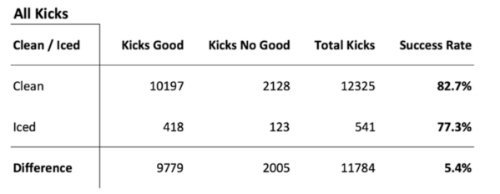
By Steve Cavolick
The NFL season is already almost half-finished and teams are separating themselves into the categories of Contenders or Pretenders. Sundays are full of wins, losses, and strategic on-field decisions; Mondays are for second guessing those decisions.
One decision coaches are faced with is whether or not to take a time out before an opposing kicker attempts a field goal or extra point to “ice” them. A prevailing thought in coaching is that kickers in high-leverage situations are nervous and tight, and that allowing them on the field to set up, then taking a time out will mess with their routine, get in their heads, and make them less likely to split the uprights.
But does icing the kicker really work? Thanks to awesome statistical research into 15 years of kicks in this article, the answer is that it depends on the situation. First, they examined kicks that occurred in the last 80 seconds of a game that could determine the outcome of the contest. The results are as follows:

The conclusion drawn from this data is that icing the kicker when the game is on the line does reduce the kicker’s effectiveness, but only by one-tenth of one percent. In reality, the net effect is zero.
The study then removed data filters for the last 80 seconds of the game and broadened its analysis to include kicks that occur at any point in the game. The results this time showed an increase in miss rate of over 5% when icing the kicker occurs.

Finally, since the distance of a kick is the key driver for success, the study examined iced/non-iced kicks occurring at any point in the game at various ranges of distance.

The data shows that icing the kicker begins to be effective when the kick distance is greater than 34 yards. The impact manifests itself at any point in the game and increases the longer the kick is. Knowing this, coaches now have a better understanding of when using one of their time outs will incrementally decrease a kicker’s chance of success.
The incremental approach to improvement should also be taken when considering an analytics project. While we never recommend embarking on a project if you can’t demonstrate an ROI, you do not need to demonstrate all the ROI in the first phase of your project. Massive change does not need to occur immediately in order for improvement to take place.
To illustrate this, let’s think about our personal lives: if you wanted to lose 20 pounds, you should not reasonably expect to lose all the weight in the first month. But with some small changes to portion size, diet, and exercise, it is not out of the question to lose a few pounds per month. A consistent monthly incremental loss would have you at your target weight within a year.
The same approach should be used in analytics when trying to solve a business problem. For example, if a community bank with $1 billion in assets under management had a goal of increasing those assets by 20%, they should not expect the outcome to occur organically within a short period of time. They could use analytics to better segment customers for cross-selling and up-selling opportunities, figure out which customers will become candidates for wealth management through lifetime value calculations, or even track large transfers of money in and out of the bank to preserve those assets. Moving the needle by only 5% in the first year would add $50 million and put them on a path to meeting their goal.
The Big Bang approach to analytics rarely works. Our advice is to start small, create a success with a demonstrable return, then continue improving that department or move onto another area of the business.
The LRS Big Data and Analytics team has 20 years of experience in helping customers increase profitability, reduce risk, and improve efficiencies through better analytics and information governance. If you are interested in understanding how we can help you create a competitive advantage with analytical applications, please fill out the form below and let us know how we can help.
About the author
Steve Cavolick is a Senior Solution Architect with LRS IT Solutions. With over 20 years of experience in enterprise business analytics and information management, Steve is 100% focused on helping customers find value in their data to drive better business outcomes. Using technologies from best-of-breed vendors, he has created solutions for the retail, telco, manufacturing, distribution, financial services, gaming, and insurance industries.